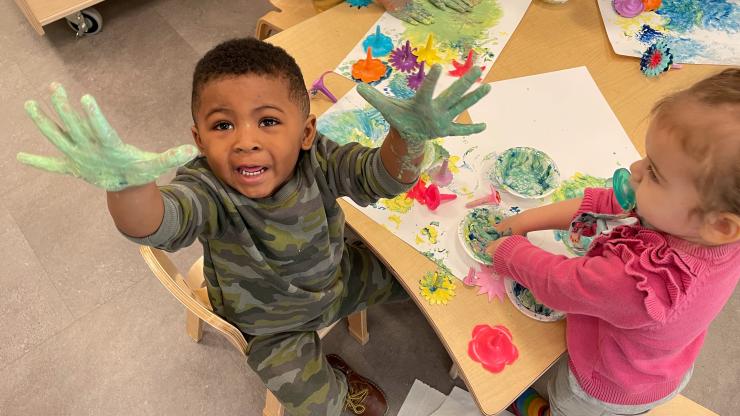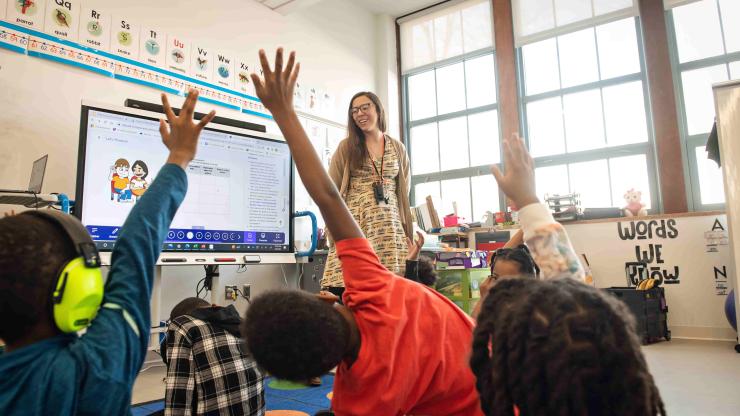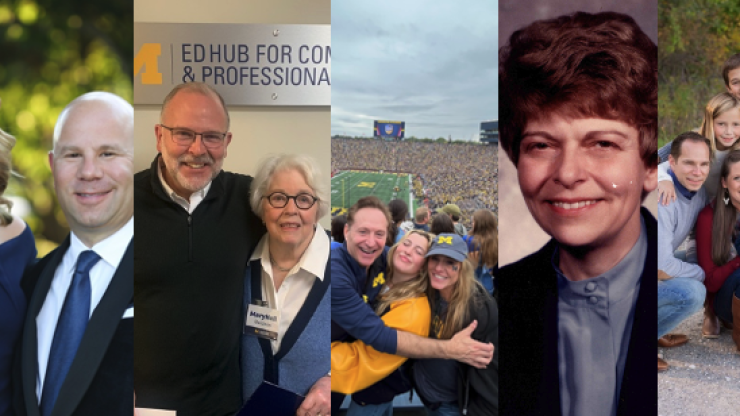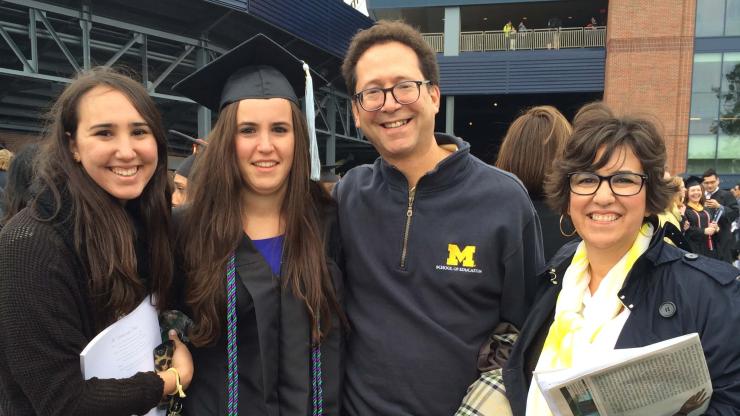2022–23 Alumni Award Recipients
In 2022, the Office of Development and Alumni Relations established two annual alumni awards: The Emerging Leader Alumni Award and the Distinguished Alumni Award. Each award recognizes the incredible accomplishments of alumni, whether they are newer to their careers, or seasoned professionals.
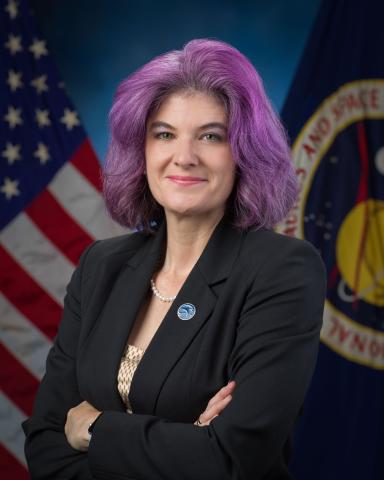
Alicia Baturoni Cortez
Alicia Baturoni Cortez (AB ’95) opens doors. Working on behalf of NASA’s Office of STEM Engagement, she gives students of all ages a peek into the agency in charge of space exploration. However, she knows from personal experience how important it is not just to hold the door, but to show learners ways forward once they step inside.
Cortez grew up in Livonia, Michigan, the daughter of a father who emigrated from Mexico, and a mother who came from a working-class family in Detroit. Throughout her childhood, her parents emphasized the importance of earning a four-year college degree. “But I didn’t have anyone’s footsteps to follow in,” says Cortez. “I didn’t really get what that meant.”
As a first-generation college student at U-M, she found herself overwhelmed by the magnitude and prestige of the university, and was unsure how to pursue her passion for science. She knew she had to get a job after graduation, but she didn’t know how to direct her interest.
Then she found a program at what was then the School of Education that was recruiting students who specifically wanted to become science teachers.
“Even that long ago—over 20 years—there was a shortage of qualified science teachers. The program was funded by the National Science Foundation to address the need, and to really take a different approach to preparing science educators. It was the foundation for everything I’ve done since.”
Along with her cohort, Cortez took specialized classes taught by biology and physics faculty. The program was rigorous. She was introduced to project-based learning, new technology, and innovative software. Sometimes the intensity of it all was tear-inducing. But rather than highlight their own research, or make the courses as hard as they could, the professors “were focused on, and passionate about, education. They wanted us to leave their classes really understanding and loving the material,” says Cortez. The program gave her the confidence to follow her dream of pursuing a career in STEM.
Several years into teaching science in the Walled Lake Consolidated School District, Cortez attended a summer professional development workshop hosted by Glenn Research Center in Cleveland, Ohio. For two weeks, she learned about the technical applications of math and science used by employees who worked there. She was given teaching materials—educator guides, posters, and models—to help explain to her students that the concepts they were learning in class were the same ones NASA used to develop the technology needed for space exploration. As she toured the center’s labs in awe, filming it all on her camcorder, Cortez thought to herself, This is where I should be.
“U-M set me up for being on the cutting edge, doing the thing that no one else is doing—and here was this whole federal agency that was doing cutting-edge exploration. It was an environment of people who were super passionate about science, but who also cared very much about education and really wanted to do right by educators,” says Cortez. “That led me to seek out more opportunities with NASA.”
Within a few years, she was working as a contractor for NASA, conducting workshops for teachers across the country to help them make connections between what their students were learning and NASA initiatives. Eventually, Cortez transitioned into a civil service role, joining NASA’s Office of STEM Engagement (NASA’s education division), to engage students—from preschoolers through postdocs—in the organization’s mission.
“My job was to build bridges between the technical and the educational sides of NASA to create opportunities, materials, resources, and experiences for students, institutions, and educators,” she says.
For instance, Cortez partnered with the Exploration Systems Development Mission Directorate to develop a K-12 curriculum that tells the story of Artemis I, the first in a series of increasingly complex missions that will enable human exploration to the Moon and Mars. As a former classroom teacher, Cortez was well aware of how daunting and time-consuming reading a 60-page educator guide can be. In developing the Artemis I STEM Learning Pathway, her goal was to make the materials as accessible as possible. To disseminate those resources, Cortez deployed a weekly newsletter that reached subscribers located in every U.S. state and over 144 countries around the world.
“The intention that I started with was meeting teachers where they were at. We really tried to dig through everything that NASA has and find the best resources, so if you got the email on a Tuesday, it would have, say, a four-minute video and a 10-minute activity that you could weave into your lesson plan. We tried to build themes, so that each week, if a teacher had just a few minutes, they could inject Artemis into what they were teaching.”
Cortez was also charged with scaling up an initiative at the Johnson Space Center for community college students from Texas. Although she had plenty of experience providing professional development for K-12 instructors, higher education was a new frontier. She went into research mode, learning everything she could about community colleges and the students they serve.
“I learned that a lot of the students were like myself. They knew they needed to go to college, but they weren’t quite sure what to do once they got there. A lot of them were really interested in STEM, but they weren’t sure how to pursue it. How would it translate into a career?”
Cortez redesigned an experience that would not only open the door to community college students by giving them a positive “behind the scenes” view of what happens at NASA, but also give them a pathway to follow once they stepped across the threshold.
“I wanted to help students see that even though NASA is the gold standard, it doesn’t mean it’s not for you. Anyone who’s interested and passionate not just about STEM, but honestly any field you can think of, there’s somebody at NASA doing that,” she says.
Cortez expanded the initiative to an agency-wide program at all 10 NASA centers, now called NASA Community College Aerospace Scholars (NCAS). After spearheading a new recruitment strategy, NCAS saw a 30 percent increase in the number of students who attended from minority serving institutions. As well, the number of women participants increased by 29 percent, creating a 38.8 percent female to male ratio in the program—exceeding the national average for women in the U.S. science and engineering workforce. In 2021, the program’s success was recognized with a NASA Honor Award Achievement Medal.
In addition to providing access to NASA’s many offerings and opportunities for students, Cortez is just as dedicated to creating an environment of inclusion and equity within the organization. In 2021, as a member of Johnson Space Center’s external relations DEI team, Cortez designed and facilitated the Diversity, Equity, and Inclusion Summer Learning Challenge for her colleagues. The 10-week challenge grew out of a desire to have concrete, measurable outcomes to accompany the organization’s social justice and inclusion efforts. Thirty percent of the organization registered for the challenge, resulting in over 170 hours of completed coursework. Cortez’s creative design and delivery of DEI activities were recognized with the 2022 Johnson Space Center Director’s Innovation Team Award.
Cortez currently serves as the integration manager for the Minority University Research and Education Project (MUREP), which works with students from minority serving institutions. The project’s goal is to remove barriers and create opportunities for learners from communities that have been historically underrepresented in STEM.
For Cortez, encountering NASA for the first time meant she could connect with other “space nerds” who were as excited about teaching as she was. Now, when she meets students who say “This is where I want to be,” she’s eager to show them what’s next.
“For students who traditionally have not seen themselves as people who could be successful in STEM, we’re showing and giving them opportunities to find their space. It’s not just opening the door, but ‘Come in, here’s what I have to show you.’”
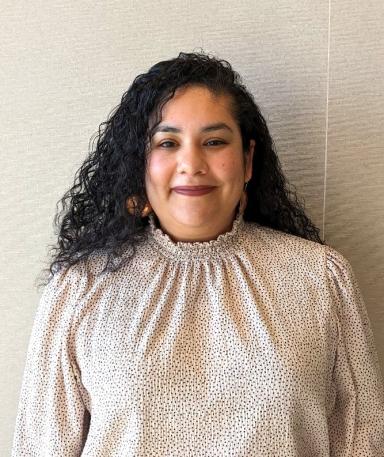
Jessica Cañas
For Jessica Cañas (AM ’14), her first love will always be nature. Cañas grew up in the Albany Park neighborhood of Chicago, frequenting the museums, botanical gardens, and forest preserves that first awakened her interest in the outdoor world. Her curiosity was further stoked on summer vacations to Michoacán, the region in Mexico where her extended family lives, and where monarch butterflies famously migrate. Her reverence for nature led to a high school internship at Chicago’s Field Museum and eventually to the Peace Corps, where she learned about sustainable agriculture practices in Honduras. Yet what brought her to the University of Michigan wasn’t the sciences: it was pursuit of a degree in higher education.
As a graduate student in the Center for the Study of Higher and Postsecondary Education (CSHPE), Cañas says she was often asked what someone who was passionate about environmental conservation was doing in a program focused on higher education. To many, the connection wasn’t obvious; to Cañas, it made perfect sense.
The Peace Corps program Cañas had embarked on included in-country service as well as graduate studies at Cornell University’s College of Agriculture and Life Sciences. Although her time in Honduras was cut short due to increased violence in the country, she went on to Cornell to complete her coursework. By that point in her academic career, she was used to being the only woman or the only Person of Color in STEM settings, but until then she had always had her family nearby to support her.
“I think being away from home really added to those feelings that are very typical for first-generation Students of Color. Feeling unwelcome or unseen, not supported in the way that you need to be. It was a hard time for me, and it was what got me thinking about higher education—how it supports Students of Color, first-generation students, low-income students like myself—specifically in STEM fields. STEM was my passion, and it still is to this day. It was really disheartening to see that I didn’t feel I had the support that I needed in order to finish my degree.”
Cañas left the program at Cornell and moved back to Chicago. She returned to the Field Museum to lead the internship program she had participated in as a high school student.
“I was working with primarily Students of Color from the southeast side of Chicago, looking at environmental issues in their communities and creating projects to address them. I was also trying to encourage them to go into the sciences. I saw myself in them and I was concerned with what they were going to experience in higher education.”
One day at work, Cañas found herself seated around a table in a meeting. “We were talking about engaging communities in conservation in Chicago. I was the only Person of Color at the table. I was the only person that was from Chicago. I asked myself what made it possible for me to be part of that table. And the only thing I saw that we all had in common was a college degree. I knew that in order to diversify those tables, we needed to get more Students of Color through higher ed with degrees in STEM so that they could be at the table to represent their communities and their needs.”
The experience galvanized her to apply to graduate school once more—this time to pursue a degree focused on access and equity in higher education.
As a master’s student in CSHPE, Cañas joined a research team where she was introduced to methods of collecting and analyzing data. She learned about critical race theory and student development theory, and was particularly interested in Dr. Tara J. Yosso’s theory of Community Cultural Wealth—the skills, abilities, and contacts possessed and used by Communities of Color to survive and resist racism and other forms of oppression. She also learned about minority-serving institutions, and wondered if, had she known about such schools when she was applying to college, she might still be in the sciences.
After graduating, Cañas carried her knowledge and experience with her when she took a position as the college pipeline specialist at Enlace Chicago, an organization that serves the primarily Mexican immigrant Little Village community on the southwest side of the city. She focused her work in three areas: partnership building, parental education, and research.
When Cañas’s supervisor Astrid Suarez observed the lack of communication between middle and high school counselors, the two worked together to build inter-school relationships to help ease students’ transitions between grades.
“We know that in order for a student to have a smooth transition from high school to college, they first need to have a strong transition from middle to high school. There’s a lack of communication between those two systems even though they’re part of a bigger public school system. We know that transitions are pivotal for students. Not only is it transitioning from one level of education to another, there are a lot of social and emotional transitions happening. A lot of physical transitions are happening, biological transitions. It’s very easy to lose a student in that.”
Drawing from her CSHPE coursework, Cañas joined Suarez in co-developing a curriculum for Little Village parents called Parent Leaders for College, an eight-month course taught in Spanish covering topics that help parents support their kids as they get into and go through college. In the future, Cañas hopes to convert the course into a community college certificate program so that participants can become certified as parent advisors to help peers navigate the higher education process with their own children.
In 2017, Cañas published the “Little Village College Enrollment Report: Where Data Calls for Social Change,” a qualitative and quantitative data analysis that shed light on the nuances surrounding the complexity of the transition from high school to college for the community’s Latine students. As a community-based organization, Enlace could not access Chicago Public Schools data, so Cañas partnered with a third-party academic institution—the University of Chicago’s To&Through Project—to obtain a quantitative data source. Her partners at the University of Chicago were “amazed” by how she and her colleagues used the data to look at an entire community. As a result of the report, the To&Through team developed a new digital tool specifically for communities to navigate high school and college enrollment data by Chicago neighborhood.
“The reason why I feel so strongly about community-based organizations doing their own research is because knowledge can be created outside of academia,” says Cañas. “I see doing research as a form of resistance for Communities of Color, so that they can see for themselves the data on their own community.”
“Jessica is a staunch advocate for the inclusion of community voices,” write the CSHPE cohort peers who nominated her for the Emerging Leader Alumni Award. “Her work consistently promotes and embodies diversity, inclusion, justice, and equity.”
After seven years working in the Little Village community, Cañas recently moved into a new position with a citywide agency, Kids First Chicago, to broaden the impact of her work. As a senior manager of community engagement, she looks forward to engaging parents in advocacy so that the policies of the city’s school board reflect their voices.
From providing students exposure to the natural world to navigating the world of higher education, Cañas’s thruline remains the same: she pushes for transparency and inclusion every step of the way.
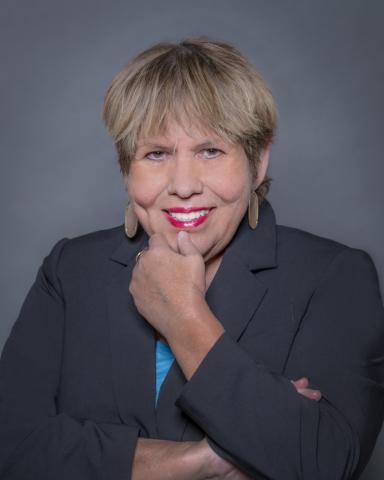
Laura I. Rendón
Growing up in Laredo, Texas, a town on the U.S.-Mexico border, Laura I. Rendón looked up to teachers. Along with priests and law enforcement officers, teachers, she says, were some of the few respected professionals visible in the low-income, isolated area where she was raised. But in high school, as a member of Future Teachers of America, she was told by the sponsor of the program to forget her dream of becoming an educator because Rendón had failed chemistry. The sponsor didn’t ask why she had failed. (Rendón had gotten caught in a rainstorm and badly sprained her knee. She couldn’t walk to school for two weeks. When she returned, she was unprepared to take a test.)
“She just assumed that I had failed, and that was it,” says Rendón. “I remember feeling rather sad about that, but something told me just to keep going. And so I did.”
Rendón recently recounted the beginning of her educational career in her autobiography, “A First-Generation Scholar’s Camino de Conocimiento,” published in 2020 in Higher Education: Handbook of Theory and Research. Immediately after graduating from high school, she enrolled at Laredo Junior College (LJC), the only institution of higher education in her hometown. When she ran out of courses to take at LJC, she transferred to San Antonio College—where she was recently named an outstanding alumna—where she earned an Associate of Arts degree. She transferred once again—this time to the University of Houston, where a friend was attending college. Her mother took the long Greyhound bus ride with Rendón to campus, terrified that something would happen to her. This was the first time any of her daughters had traveled that far away from home.
“In the Latino community, they hold their children very, very close. Sometimes, when you’re the first to go to college, they want to keep you as close as possible. So going to Houston was a struggle,” says Rendón.
It was the height of the Vietnam War. Protests raged throughout the country, she recalls. But when she set foot on the university campus, she was elated.
The friend who encouraged her to join him at school was Raúl Garza. Like Rendón, Garza was a low-income student from Laredo. He loved to collect catalogs from universities across the country.
“Raúl was an inspiration because he totally believed in higher education. He is the reason I went to the University of Houston—because I had a friend there,” says Rendón. “We would talk about our times in Laredo, and what we wanted to be. We also talked about getting doctoral degrees.”
In 1970, Rendón earned her bachelor’s degree, becoming the first in her family to graduate from a four-year college.
“I had successfully crossed the academic border which before had seemed so inaccessible,” writes Rendón in her autobiography.
Rendón was popular with the eighth graders she taught back in her hometown. (As soon as she graduated, her family insisted she return home.) She used music by the Beatles to turn her students on to poetry. She connected literature to contemporary issues. She had her students write and perform their own plays. During those early years in the classroom, she began to gain more confidence, and noticed that people regarded her in the same way she had admired teachers herself when she was a child. In her autobiography, Rendón writes that she could have easily spent her entire working life at that school, but her intuition told her there was something else in store for her professionally.
Interested in psychology, Rendón began taking night classes at Texas A&I University (known today as Texas A&M University-Kingsville), with the aim of becoming a school counselor. But when she graduated with her master’s degree, there were no counseling positions available in the Laredo Independent School District. Instead, Rendón took her first job in higher education at her alma mater, LJC, working as a counselor and teaching psychology. She taught in a Title III program, a learning community of low-income Mexican American students, with an interdisciplinary approach to writing, reading, history, Spanish, psychology, and counseling—all designed to prepare students to transfer. Within a year, she had been promoted to director of the program. At 26 years old, she held the status of department chair.
Each year, faculty from the University of Texas who oversaw a community college leadership program came to LJC to evaluate Rendón’s program. She was proud of her program’s success, which boasted a high retention rate, and always received high marks. It was through visits with these faculty that Rendón learned about higher education doctoral programs. As soon as she did, she knew that would be her next step. She applied to two programs in Texas, but once again, a test nearly stood in her way. One program accepted her conditionally on account of her low GRE score. However, the University of Michigan offered her a generous financial package and accepted her without condition.
“When I opened the acceptance letter [from the University of Michigan], I jumped for joy. I knew my life was about to change,” writes Rendón.
Back at the University of Houston, when she had felt overwhelmed by the challenges of school, and of being a first-generation student, Rendón went to the student union to take solace in listening to music. Stan Getz and Astrud Gilberto’s Brazilian bossa nova album featuring “The Girl from Ipanema” and Armando Manzanero’s album of romantic Mexican songs, including “Esta Tarde Vi Lover,” calmed her. Friends like Garza, and later the small but tight-knit community of Latinx students she met at U-M, were instrumental in her student experience.
“Without that support I would not have had a sense of family, and it would have been much more challenging to complete a doctorate,” writes Rendón. Concerned about the lack of Hispanic representation on campus, the community formed an organization, Coalition of Hispanics for Higher Education. Rendón served as president. The coalition lobbied U-M’s president, deans, and director of affirmative action to recruit more Latinx students and faculty.
Inspired by her personal experience, and the students she met along the way, Rendón devoted her scholarship to advocating for students like herself—those who came from low-income backgrounds, first-generation students who she felt had hopes and dreams but often did not know how to realize them.
In 1994, Rendón wrote the article, “Validating Culturally Diverse Students: Toward a New Model of Learning and Student Development,” in which she established the groundbreaking validation theory. This theory, consisting of six elements, is defined as “an enabling, confirming, and supportive process initiated by in- and out-of-class agents that fosters academic and interpersonal development.” Validation theory has been used extensively to theoretically frame college and university programs such as the Puente Project (California) and Catch the Next (Texas). The theory has also been employed in student affairs programming, student success programs, research capturing the experience of low-income and first-generation students, and dissertation studies.
Today, Rendón holds professor emerita status at the University of Texas-San Antonio. Her development of validation theory, as well as her book, Sentipensante (Sensing/Thinking) Pedagogy: Educating for Wholeness, Social Justice and Liberation, represent two scholarly contributions that transformed higher education scholarship on student development as well as contemplative teaching and learning rooted in social justice. Currently, Rendón is Director of Education for the International Society for Contemplative Education. She has given hundreds of keynote addresses, and led workshops and research presentations for national and international colleges and universities, educational organizations, and nonprofit entities. She has held faculty and administrative appointments at a wide range of institutions including the University of South Carolina, North Carolina State University, Arizona State University, California State University-Long Beach, Iowa State University, and University of Texas-San Antonio. Along with Sentipensante (Sensing/Thinking) Pedagogy, she has co-edited nine books and monographs and has an extensive list of scholarly publications focusing on success for underserved student populations. In 2021, Rendón was recognized by the Association for the Study of Higher Education (ASHE) with the prestigious ASHE Bowen Distinguished Career Award. Her personal archives are a part of the Nettie Lee Benson Latin American Collection at the University of Texas-Austin, one of the premier libraries in the world focused on Latin American and Latinx Studies.
In 2016, Rendón stepped down from her faculty position at the University of Texas-San Antonio. In part, she says, her choice to retire was driven by a desire to make room for those who will pick up where she left off. Rendón is excited to see the work of younger colleagues who continue to advance scholarship in her field. In support of their efforts, she established The Laura I. Rendón Dissertation Finishing Grant for Equity and Justice in 2022. The grant provides funding to Marsal School doctoral students in the Center for the Study of Higher and Postsecondary Education who are researching topics related to justice and inequity in American society.
As she likes to tell her friends, “I’ve retired from the university, but I haven’t retired from the work.” Rendón is part of a network of public speakers affiliated with SpeakOut-The Institute for Democratic Education and Culture. She is regularly invited to speak at colleges and universities across the country, as well as conferences and organizational meetings.
“People are very interested now in how to foster the success of low-income, first-generation students. The research that I initiated such a long time ago is still very, very relevant today. It makes me proud that I'm able to make an impact at this stage of my life, and that people are still open to listening to the messages that I have.”


